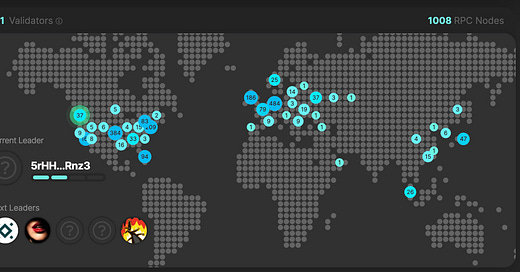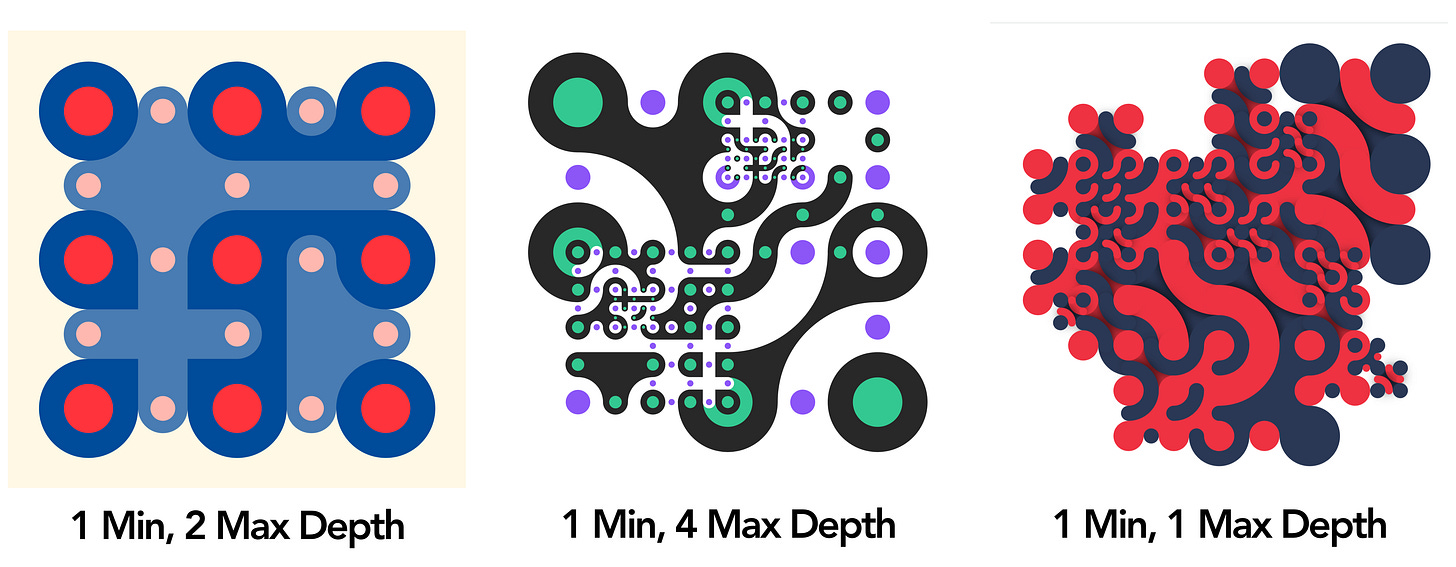This post is best viewed on the web: https://playgroundsol.substack.com/p/epoch
Playground is thrilled to share more details about the new artwork on our platform: Epoch.
Our new featured collection, Epoch, is a generative artwork created by the renowned generative artist @Eko33 (featuring this December at Art Basel Miami 2021), and inspired by the concept of time and Solana’s validator schedule. More about Eko33 at the end of this post.
In Solana, time is segmented into “Epochs” where validators come together to organize and validate the transactions flowing through the Solana blockchain. All validators join like pieces of a puzzle and are synchronized in Epochs of time.
There will be one thousand uniquely generated Epochs, each curated individually by the artist, stored on-chain and created using bespoke code and p5.js, embodying the Epochs of Solana.
Below are some more details on the construction of each Epoch, their individual traits, and the different variations that could be generated through the algorithm.
Please note: Each generated artwork is unique at the time of creation, examples shown are for illustration purposes only and may not be the exact same artwork you will receive.
Composition
Each Epoch is generated with its own individual combination of traits. The algorithm constructs and generates each unique Epoch using a combination of 7 distinctive traits, including:
Cluster Type
Neighborhood Assignment
Nodes Style
Turbine Depth
Shape
Color
Animation (Scheduled Rotation)
Cluster Type
Each Epoch is divided into multiple clusters with a variance in depth. This depth translates into large or small nodes within each cluster:
Each Epoch is composed of one of four different overall cluster types:
Maximalist depth: Contains many small nodes
Minimalistic depth: Contains large nodes
Noise cluster: Random values but grouped closer together.
Random cluster: Random values chosen by the algorithm (can have large gaps).
Neighborhood Assignment
Each Epoch has one type of “Neighborhood Assignment” affecting the number of colors, content of each tile, and how it connects with other tiles nearby.
Epochs have 4 neighborhood assignments available:
MSBI-Color-1: One color combination
MSBI-Color-2: Two color combinations
MSBI-Color-3: Two color combinations plus circle and arc patterns.
MS4-Color-1: Four color combinators
MSBI-Color-Shadow-Alpha: Special type where certain tiles contain transparency and shadows. Two variations are shown below:
Node Styles
When each Epoch is being built, it starts with a cluster type, then a neighborhood assignment style. The third step is the creation of different nodes to fill in each Neighborhood Assignment. This is when the nodes’ system comes in.
There’s a palette of 15 different nodes available. Each node can be combined with every other, no matter which position or scale it’s in.
An Epoch will have a certain number of nodes available (up to 15) and based on this number, random nodes will be selected in the nodes pool and applied during the Epoch’s construction.
Turbine Depth
Looking closely at your Epoch you’ll see different patterns can be repeated with a different scale. This scale relies on the “depth parameters”. A low value for the depth will display a large node and a high value will display more recursively in each tile, resulting in having a tile with smaller nodes inside it.
The “Turbine depth” parameter has been inspired by the “Turbine Block Propagation” algorithm used in the Solana architecture.
Shapes
An Epoch can be built inside a square shape or a random one. Random shapes are composed of two shapes joined together and applied on the initial shape.
Beyond the shape there’s also a filter applied to each Epoch.
The filter will whitelist specific depth values. For example, a filter could be applied only to depth levels two and three. This setting is filtering out all depth levels which do not match the values two and three.
Colors
There’s a total of 711 color palettes. 50% of them originate from colors of logos from the Solana ecosystem. The other 50% has been selected manually by the artist Eko33.
Animation (Scheduled Rotation)
Each Epoch has an animation system built-in called a “scheduled rotation”. The scheduled rotation concept was inspired by the concept of “leader rotation” of each Epoch in Solana’s consensus mechanism.
By default, each Epoch will start in a static mode, and will rotate automatically after 5 minutes. Pressing the spacebar (for devices which have a spacebar) will make you enter a non-deterministic mode where random sequences will be ephemeral and won’t be able to be seen again.
Before going into details about the composition of one pattern, let’s look at how each pattern is sequenced. Each Epoch is programmed with one type of scheduled rotation, either “loop” or “infinity” mode.
Loop mode - Composed of 33 random patterns, after the 33rd pattern it goes back to the beginning and starts over again.
Infinity Mode - For infinity mode at the end of the 33rd pattern, a new sequence of patterns will be created and the process will be limitless.
With these two types of modes, here is a short introduction on what each animation pattern is composed of. Each animation pattern is composed of coordinates, synchronization parameters and a velocity curve.
The coordinates dictate where on the Epoch the animation will take place.
The velocity curve represents the movement of each pattern.
The additional synchronization attribute can result in all of the patterns having or not having the same velocity curve.
Eko33 has identified an ensemble of 8 velocity curves especially suitable for Epoch including:
OutExpo
OutQuad
OutQuint
OutElastic
InOutExpo
InOutCirc
OutBounce
OutElastic
Depending on your Epoch’s configuration, your patterns will all be moving together using the same velocity curve. Or they will independently use a specific velocity curve creating an overall asynchronous movement.
The very last criteria involved in the display of the animation is the “leader schedule”. Like its role in the Solana block validation protocol, the leader schedule assigns a duration of time for each animation pattern.
Unique Hash
Each Epoch is fingerprinted with a unique hash address, specifying the specific combination of traits used to generate the exact same Epoch again. We have plans to use this hash address to allow the owners of each Epoch to be able to replay the generation event in a “live view” functionality which will be available on our platform Playground.
Collecting
As of this writing, we cannot be sure which traits will be rare, but there will be some surprising and unique Epoch based on all of the collective traits. We hope this overview helps give a deeper appreciation of the algorithm behind the artwork and the Epoch pieces themselves. We will be announcing the drop date for Epochs soon, so be sure to subscribe to all of our social channels below to stay up to date with Playground and Epochs!
Who is Eko33?
Since 1999 Eko33 has been experimenting with digital arts. His first experiments were made with a “portable” Commodore SX-64.
Starting with Max/MSP, Processing and Nato.0+55+3d, his first exhibition occurred in 2004 at Seoul’s Museum of Art during the International Media Art Biennial.
After completing his academic training, he taught creative coding within world-class art schools in France and Switzerland.
Since then, he has been obsessively building autonomous artistic systems worldwide.
"Writing your own code as an artist gives you the freedom to do what you want as long as you have the patience, knowledge, and determination to achieve what you want.”
Eko33’s artworks will be displayed at Art Basel Miami, December 2 - 4, 2021
One of his creations was recently displayed a few weeks ago in Shenzhen during “NFT Art Week Shenzhen” on a 79 foot screen:
About Playground
Playground is a platform focused on generative works of art stored immutably on the Solana blockchain. Solana is an energy efficient, high throughput, fast, and secure blockchain built for global scale.
Follow us
Website: https://www.playground.ink/
Discord: https://discord.com/invite/Crq97g44SH
Twitter: https://twitter.com/playground_sol
Substack: https://playgroundsol.substack.com/
References:
The multiscale approach was inspired by research conducted by Christopher Carlson at Wolfram Research http://archive.bridgesmathart.org/2018/bridges2018-39.pdf













I’m really impressed watching the playground ecosystem evolve, excited to be part of the group!